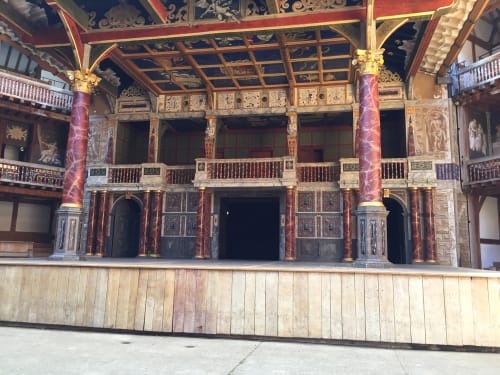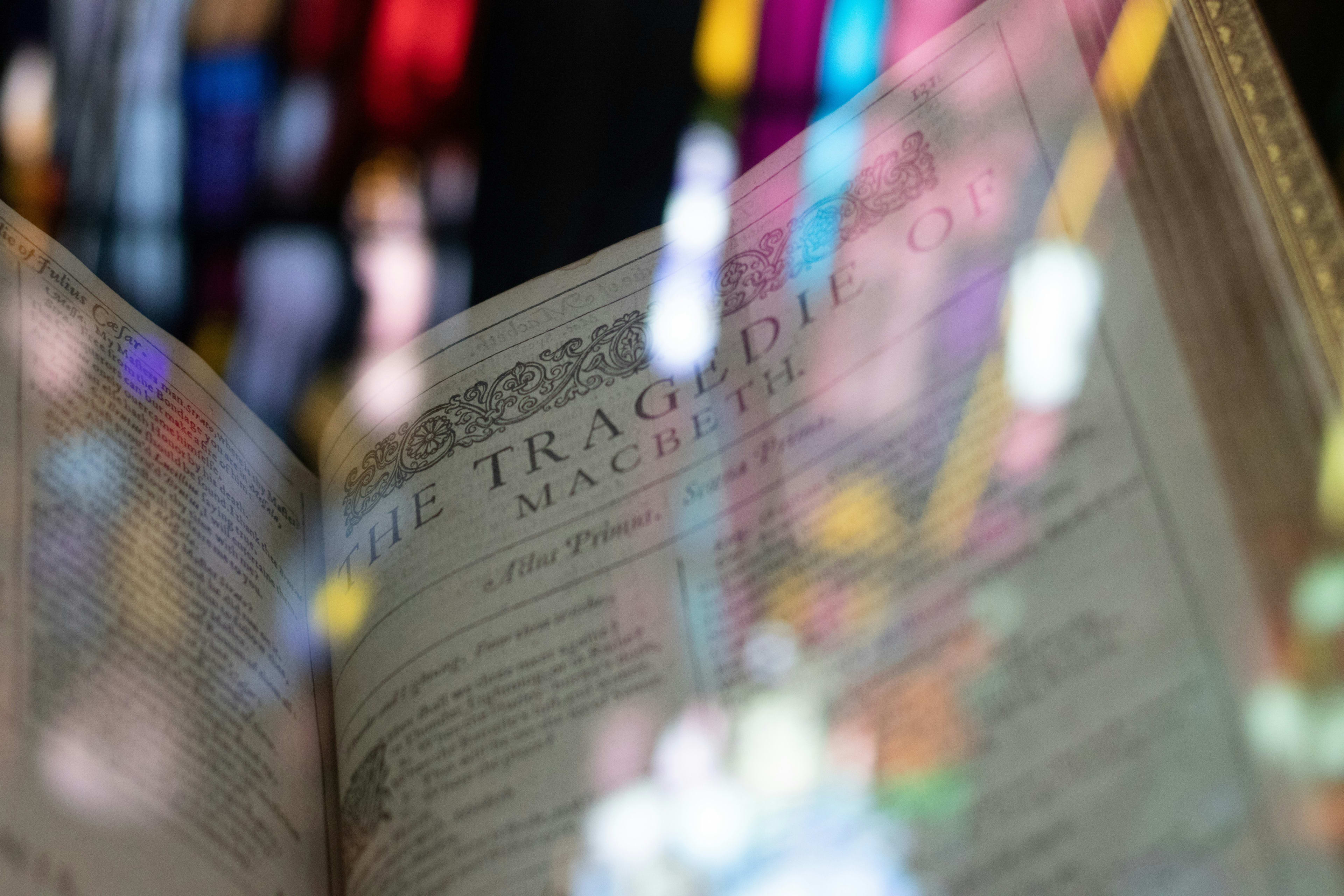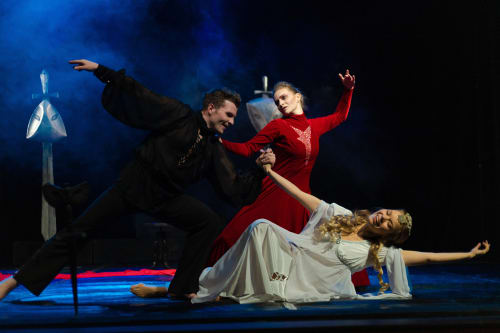Did You Know? 10 Facts About Shakespeare’s Globe Theatre
Situated on London’s Bankside, Shakespeare's Globe Theatre reconstructs the open-air playhouse where the playwright penned his greatest work.
Many people ask: What was the name of Shakespeare's Theatre?
The Globe Theatre is its official name!
Take a look at our 10 dramatic Shakespeare's Globe Theatre facts, including...
- The remarkable story of the first Globe Theatre
- And how it burnt down
- The remarkable story of the new Shakespeare's Globe Theatre
- And how they've tried to protect it from burning down like the last one

1. Shakespeare’s Globe Theatre was built 400 years after the original, just yards away
Completed in 1997, Shakespeare’s Globe Theatre is the third Globe Theatre to have been built on the Southbank of the Thames. The original Globes were located just a street further back from the river. The original globe theatre was built in 1599, and was destroyed by fire in 1613. It was rebuilt a year later but turned into tenement buildings in 1644 after puritanical fears about stage plays meant London theatres were forced to close in 1642.
2. Shakespeare’s Globe Theatre was rebuilt to be as similar to the original Globe as possible
The Third Globe—what is known as Shakespeare’s Globe Theatre—was designed to be as close to Globes One and Three as possible. A great deal of research went into the shape and layout of the original theatres, and the type of wood and building techniques used. It is made of the same wood—green oak—the original builders would have used, and the timbers are fixed together using wooden pegs.
Of course, modern health and safety measures had to be incorporated into the design, including the lining of the thatched roof with fire-retardant material.

3. Building the original Globe was a drama in itself
The original Globe was built by the theatre company Shakespeare was in, the Lord Chamberlain’s Men (later known as the King’s Men). It was erected using timbers recycled from The Theatre in Shoreditch, the first playhouse to put on Shakespeare’s work. Their old landlord, a Mr Allen, wouldn’t say ‘recycled’. He’d prefer the word ‘stolen’.
The story goes that Mr Allen refused to renew their lease for the land The Theatre stood on. So the company—including Shakespeare—armed with daggers and cudgels, snuck onto Allen’s land while he was away for Christmas. They took all the main timbers and stored them in a yard north of the Thames.
4. Shakespeare was part-owner of the theatre
The family of Richard Burbage, the company’s leading actor, had built The Theatre at Shoreditch, but didn’t have the money to lease a site for the new playhouse. So they asked for investment from some members of the company. William Shakespeare became a 12.5% shareholder in the Globe Theatre, paying £10 for his share. Now they just needed someone to write some hugely popular plays so they could get bums on the seats and returns on their investment...

5. It’s always been a midsummer destination
Because of its open-air aspect, The Globe has always been a fair-weather destination for watching a performance. Back in Shakespeare’s time, the company would move indoors to perform during winter. The same is true today, with winter performances taking play in the adjoining Sam Wanamaker Playhouse. But tours of Shakespeare’s Globe Theatre, which offer a wealth of insights into the theatre as it was in The Bard’s time and as it operates today, are available year-round. They are free with a London Pass. You can also check out other fascinating things to do in London in our write-up.

6. Shakespeare referenced the Globe in his work
Henry V mentions “this wooden O,” in the play of the same name. Prospero speaks of “the great globe itself,” in a pivotal moment during The Tempest. It makes sense that he would. Firstly, as a tribute to a place that was so important to him. Also, there’s something particularly engaging and inclusive about someone on stage referring to the place where all the players and the crowd are assembled—“Good evening, Glastonbury!”

7. He might have paraphrased its motto
It is said—although sources are pretty thin on the ground—that the motto of the Globe was Totus mundus agit histrionem, meaning ‘The whole world is a playhouse.’ This is remarkably similar to the famous phrase from As You Like It: “All the world is a stage.”

8. They used to flag up the genre
Different flags were used to signpost what kind of play was being performed that day. Flying high above the theatre, they were a good way of advertising the genre of the performance, or notifying prospective theatre-goers of a last-minute cancellation. This was true of many Elizabethan theatres.
Black flags were raised for tragedy plays. Red ones announced history plays. Comedies were signalled by the flying of white flags. So that’s why they didn’t put on my one-man show, The Tragic Life of a Very Funny Person Who Lived a Billion Years Ago. It wasn’t that it was a steaming pile of pretentious nonsense. It was a question of flags. Of course!

9. They built it along the lines of the Colosseum in Rome (just a bit smaller)
Many Elizabethan playhouses were. The tiered seating areas ring around the stage. In the past, they could hold up to 3000 spectators, but now spectators get a little more wiggle room for when legs start twitching around Act Four.
Those watching from ‘The Pit’, the standing area at the foot of the stage, were (not very respectfully) nicknamed ‘groundlings’. These were the cheaper than cheap seats. So cheap that they weren’t seats at all. But you could watch plays from the pit for just a penny. In Shakespeare’s Globe Theatre—the theatre that stands today—this is still the most affordable place from which to watch a performance. Nowadays, you can get tickets for as little as a fiver.
10. Henry VIII burnt down Shakespeare’s Globe Theatre
Woah! You clicked on it! A history-related bit of clickbait. AHAHAHA GOTCHA! Alright, sorry, this site doesn’t work like that. It wasn’t that Henry VIII burnt down Shakespeare’s Globe Theatre. He did a lot of terrible things in his time. But he was dead nearly 20 years before Shakespeare was born.
On June 29th, 1613, during a performance of Shakespeare’s Henry VIII, some small cannons were fired, with no balls inside them, but using real gunpowder. The thatched roof caught alight. The whole thing burned down in around an hour. No one was hurt. But one man’s trousers caught fire. Luckily, someone close to him threw some beer over the flames.
So, those were our Shakespeare's Globe Theatre fun facts. But before you exit this blog (pursued by a bear), take a look at our guide to taking the Shakespeare's Globe Theatre tour here.
It's free with The London Pass®.

Make planning your trip a breeze with the London Pass
Shakespeare’s Globe Theatre Tour is included in The London Pass®. This guided tour gives you an insider look at this historic theatre, outside of the performances.
The standard tour price is £24 - with The London Pass®, you’ll pay nothing at the door. You’ll spend more of your trip exploring the capital’s top sights and less time organising.

So let's wrap up the important points below:
The Globe Theatre's famous beginnings
The Globe Theatre, intimately tied to William Shakespeare, stands as an icon in the world of theatre. Built in 1599 and nestled in London's heart, this venue was the birthplace of many Shakespearean masterpieces. A curious detail? The timbers framing this historic theatre were sourced from an older playhouse.
Shakespeare's Stage: More than just a theatre
The Globe was more than a venue; it was where stories came alive. Although widely acknowledged as Shakespeare's playground, its true identity lay in its name, the Globe Theatre. Sitting by London's River Thames, its distinct round shape became the home for Shakespeare's legendary tales. Most of his plays were performed on this very stage.
And for those curious about its capacity? The Globe had space for about 3,000 attendees, who usually opted to stand in its open air yard.

Rediscovering the Globe today
Thinking of visiting London? Excited to walk where Shakespeare once did? There's good news! A tribute, aptly named 'Shakespeare's Globe', stands a stone's throw away from where the original once did. This re-engineered attraction represents Shakespeare's lasting impact. Don't miss out on this amazing experience!
Globe Theatre frequently asked questions (FAQs)
Q. What did Shakespeare do in the Globe Theatre?
A. At the Globe Theatre, William Shakespeare not only penned some of his most iconic plays but also acted and was a shareholder in the theatre's operations.
Q. Does Shakespeare's Globe Theatre still exist?
A. While the original Globe Theatre no longer stands, a faithful replica, known as "Shakespeare's Globe," was constructed close to its original site and stands today as a testament to the Bard's enduring legacy.
Q. Why is Shakespeare's theatre called the Globe?
A. Shakespeare's theatre was named "the Globe" because it symbolized the idea that the theatre looked like a "wooden O" representing the world, as mentioned in the prologue to his play, Henry V.
Q. What plays did Shakespeare write in the Globe Theatre?
A. While at the Globe Theatre, Shakespeare wrote several of his renowned works, including Julius Caesar, Macbeth, Othello, and Hamlet, among others.

Save on London attractions and explore the city to your heart’s content
Planning your London trip? With The London Pass®, you can explore big-name landmarks, local hotspots and epic tours, all on one pass, all for one price.
Not only that, but you'll enjoy savings of up to 50%, compared to buying individual attraction tickets.
☀️See London attractions☀️ – ✈️ Buy a pass ✈️
